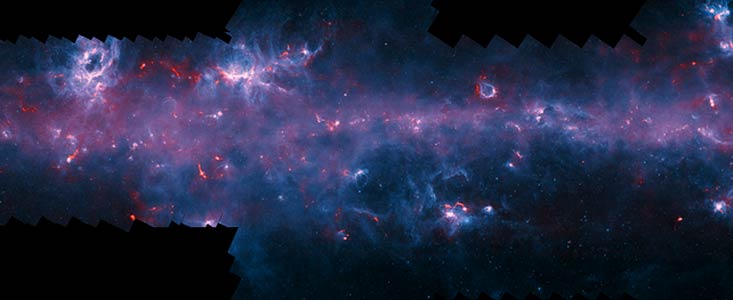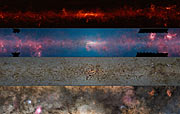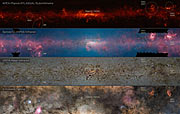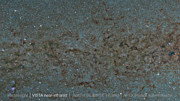Press Release
ATLASGAL Survey of Milky Way Completed
24 February 2016
A spectacular new image of the Milky Way has been released to mark the completion of the APEX Telescope Large Area Survey of the Galaxy (ATLASGAL). The APEX telescope in Chile has mapped the full area of the Galactic Plane visible from the southern hemisphere at submillimetre wavelengths — between infrared light and radio waves. This is the sharpest such map yet made, and complements those from recent space-based surveys. The pioneering 12-metre APEX telescope allows astronomers to study the cold Universe: gas and dust only a few tens of degrees above absolute zero.
APEX, the Atacama Pathfinder EXperiment telescope, is located at 5100 metres above sea level on the Chajnantor Plateau in Chile’s Atacama region. The ATLASGAL survey took advantage of the unique characteristics of the telescope to provide a detailed view of the distribution of cold dense gas along the plane of the Milky Way galaxy [1]. The new image includes most of the regions of star formation in the southern Milky Way [2].
The new ATLASGAL maps cover an area of sky 140 degrees long and 3 degrees wide, more than four times larger than the first ATLASGAL release [3]. The new maps are also of higher quality, as some areas were re-observed to obtain a more uniform data quality over the whole survey area.
The ATLASGAL survey is the single most successful APEX large programme with nearly 70 associated science papers already published, and its legacy will expand much further with all the reduced data products now available to the full astronomical community [4].
At the heart of APEX are its sensitive instruments. One of these, LABOCA (the LArge BOlometer Camera) was used for the ATLASGAL survey. LABOCA measures incoming radiation by registering the tiny rise in temperature it causes on its detectors and can detect emission from the cold dark dust bands obscuring the stellar light.
The new release of ATLASGAL complements observations from ESA's Planck and Herschel satellites [5]. The combination of the Planck and APEX data allowed astronomers to detect emission spread over a larger area of sky and to estimate from it the fraction of dense gas in the inner Galaxy. The ATLASGAL data were also used to create a complete census of cold and massive clouds where new generations of stars are forming.
“ATLASGAL provides exciting insights into where the next generation of high-mass stars and clusters form. By combining these with observations from Planck, we can now obtain a link to the large-scale structures of giant molecular clouds,” remarks Timea Csengeri from the Max Planck Institute for Radio Astronomy (MPIfR), Bonn, Germany, who led the work of combining the APEX and Planck data.
The APEX telescope recently celebrated ten years of successful research on the cold Universe. It plays an important role not only as pathfinder, but also as a complementary facility to ALMA, the Atacama Large Millimeter/submillimeter Array, which is also located on the Chajnantor Plateau. APEX is based on a prototype antenna constructed for the ALMA project, and it has found many targets that ALMA can study in great detail.
Leonardo Testi from ESO, who is a member of the ATLASGAL team and the European Project Scientist for the ALMA project, concludes: “ATLASGAL has allowed us to have a new and transformational look at the dense interstellar medium of our own galaxy, the Milky Way. The new release of the full survey opens up the possibility to mine this marvellous dataset for new discoveries. Many teams of scientists are already using the ATLASGAL data to plan for detailed ALMA follow-up.”
Notes
[1] The map was constructed from individual APEX observations of radiation with a wavelength of 870 µm (0.87 millimetres).
[2] The northern part of the Milky Way had already been mapped by the James Clerk Maxwell Telescope (JCMT) and other telescopes, but the southern sky is particularly important as it includes the Galactic Centre, and because it is accessible for detailed follow-up observations with ALMA.
[3] The first data release covered an area of approximately 95 square degrees, a very long and narrow strip along the Galactic Plane two degrees wide and over 40 degrees long. The final maps now cover 420 square degrees, more than four times larger.
[4] The data products are available through the ESO archive.
[5] The Planck data cover the full sky, but with poor spatial resolution. ATLASGAL covers only the Galactic plane, but with high angular resolution. Combining both provides excellent spatial dynamic range. Herschel has mapped the full galactic plane, but at shorter wavelengths than ATLASGAL. These datasets are highly complementary.
More information
ATLASGAL is a collaboration between the Max Planck Institute for Radio Astronomy (MPIfR), the Max Planck Institute for Astronomy (MPIA), ESO, and the University of Chile.
APEX is a collaboration between the Max Planck Institute for Radio Astronomy (MPIfR), the Onsala Space Observatory (OSO) and ESO. Operation of APEX at Chajnantor is carried out by ESO.
ALMA is a partnership of the ESO, the U.S. National Science Foundation (NSF) and the National Institutes of Natural Sciences (NINS) of Japan in cooperation with the Republic of Chile. ALMA is funded by ESO on behalf of its Member States, by NSF in cooperation with the National Research Council of Canada (NRC) and the National Science Council of Taiwan (NSC) and by NINS in cooperation with the Academia Sinica (AS) in Taiwan and the Korea Astronomy and Space Science Institute (KASI).
ESO is the foremost intergovernmental astronomy organisation in Europe and the world’s most productive ground-based astronomical observatory by far. It is supported by 16 countries: Austria, Belgium, Brazil, Czechia, Denmark, France, Finland, Germany, Italy, the Netherlands, Poland, Portugal, Spain, Sweden, Switzerland and the United Kingdom, along with the host state of Chile. ESO carries out an ambitious programme focused on the design, construction and operation of powerful ground-based observing facilities enabling astronomers to make important scientific discoveries. ESO also plays a leading role in promoting and organising cooperation in astronomical research. ESO operates three unique world-class observing sites in Chile: La Silla, Paranal and Chajnantor. At Paranal, ESO operates the Very Large Telescope, the world’s most advanced visible-light astronomical observatory and two survey telescopes. VISTA works in the infrared and is the world’s largest survey telescope and the VLT Survey Telescope is the largest telescope designed to exclusively survey the skies in visible light. ESO is a major partner in ALMA, the largest astronomical project in existence. And on Cerro Armazones, close to Paranal, ESO is building the 39-metre European Extremely Large Telescope, the E-ELT, which will become “the world’s biggest eye on the sky”.
Links
- Max-Planck-Institute for Radio Astronomy (MPIfR)
- Onsala Space Observatory (OSO)
- ATLASGAL information at MPIfR
- The Csengeri et al. 2016 paper on the combination with Planck data
- ATLASGAL papers linked in the ESO Telescope Bibliography
Contacts
Carlos De Breuck
ESO APEX Programme Scientist
Garching bei München, Germany
Tel: +49 89 3200 6613
Email: cdebreuc@eso.org
Frederic Schuller
ATLASGAL Principal Investigator - Max Planck Institute for Radio Astronomy
Bonn, Germany
Email: fschulle@apex-telescope.org
Friedrich Wyrowski
APEX Project Scientist – Max Planck Institute for Radio Astronomy
Bonn, Germany
Tel: +49 228 525 383
Email: fwyrowski@mpifr-bonn.mpg.de
Norbert Junkes
Press and Public Outreach – Max Planck Institute for Radio Astronomy
Bonn, Germany
Tel: +49 228 525 399
Email: njunkes@mpifr-bonn.mpg.de
Richard Hook
ESO Public Information Officer
Garching bei München, Germany
Tel: +49 89 3200 6655
Cell: +49 151 1537 3591
Email: rhook@eso.org
About the Release
| Release No.: | eso1606 |
| Name: | Milky Way |
| Type: | Milky Way |
| Facility: | Atacama Pathfinder Experiment |
| Instruments: | LABOCA |










